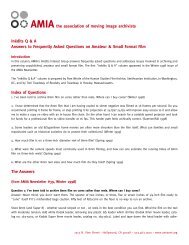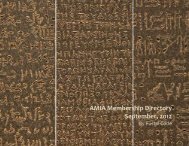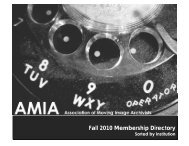Identifying and Handling Nitrate Film - the Association of Moving ...
Identifying and Handling Nitrate Film - the Association of Moving ...
Identifying and Handling Nitrate Film - the Association of Moving ...
You also want an ePaper? Increase the reach of your titles
YUMPU automatically turns print PDFs into web optimized ePapers that Google loves.
<strong>Identifying</strong> <strong>and</strong> H<strong>and</strong>ling <strong>Nitrate</strong> <strong>Film</strong><br />
December 2008<br />
35mm film stock manufactured before 1951 is nitrate. The next step is to determine what year your film<br />
is from. If you do not already know when your film is from <strong>the</strong>n do a basic search on such sites like <strong>the</strong><br />
Internet Movie Database (www.imdb.com). Any film produced in <strong>the</strong> United States after 1950 cannot<br />
be nitrate film. If you have a film that you believe to be made before 1950 <strong>the</strong>n you will need to do<br />
a basic visual inspection <strong>of</strong> <strong>the</strong> reel to determine whe<strong>the</strong>r you have a vintage nitrate print or a safety<br />
copy made after 1950. In Europe, nitrate film was produced through <strong>the</strong> first years <strong>of</strong> <strong>the</strong> 1950s <strong>and</strong><br />
on rare occasions has been found in films from <strong>the</strong> early 1960s. If you have a film you believe to be<br />
from Europe that could fall under <strong>the</strong>se qualifications <strong>and</strong> are uncertain <strong>of</strong> <strong>the</strong> film stock <strong>the</strong>n please<br />
seek out fur<strong>the</strong>r expertise by visiting your<br />
nearest institution.<br />
If you unwind <strong>the</strong> film a few feet <strong>the</strong>n you<br />
should be able to read some information<br />
along <strong>the</strong> edges, beside <strong>the</strong> perforations.<br />
Most film stock made after 1920 was marked<br />
with what type <strong>of</strong> stock it was created from<br />
with <strong>the</strong> words “<strong>Nitrate</strong> <strong>Film</strong>”, “Safety <strong>Film</strong>”<br />
or sometimes just <strong>the</strong> letter “S” which denotes<br />
that <strong>the</strong> stock is safety. If any <strong>of</strong> <strong>the</strong>se phrases<br />
can be read along <strong>the</strong> edges in black writing<br />
<strong>the</strong>n you know what you have. Make sure<br />
that you are reading <strong>the</strong> black writing <strong>and</strong> not<br />
any white writing on black – this would be an<br />
imprint from <strong>the</strong> negative from which it was<br />
made, which is not necessarily <strong>of</strong> <strong>the</strong> same film<br />
stock.<br />
Ano<strong>the</strong>r way <strong>of</strong> identifying <strong>the</strong> year <strong>the</strong> film<br />
was manufactured is by checking edge codes.<br />
These are markings along <strong>the</strong> edges (reading<br />
length wise) that denote when <strong>the</strong> film was<br />
made. Along <strong>the</strong> area where “<strong>Nitrate</strong>” or<br />
“Safety” can be read, if <strong>the</strong> words “Kodak”<br />
or “Eastman” can be read <strong>the</strong>n you can<br />
reference your symbols at this website:<br />
http://www.historicphotoarchive.com/f1/<br />
ekcode.html<br />
If <strong>the</strong>se words or symbols cannot be seen <strong>the</strong>n<br />
<strong>the</strong>re are sometimes “tick” marks that denote<br />
if <strong>the</strong> film is nitrate or safety. Again along <strong>the</strong><br />
edges <strong>of</strong> <strong>the</strong> film (not within <strong>the</strong> picture or <strong>the</strong><br />
frame) if a small black mark runs <strong>the</strong> length <strong>of</strong><br />
<strong>the</strong> film (parallel to <strong>the</strong> edge <strong>and</strong> <strong>the</strong> image)<br />
You can use <strong>the</strong> following simple pointers to establish whe<strong>the</strong>r<br />
a film you have is likely to be nitrate.<br />
* As a general rule your film can only be nitrate if it is 35mm<br />
wide, with perforations along both edges <strong>and</strong> was manufactured<br />
before 1951.<br />
* The word ‘nitrate’ printed between one row <strong>of</strong> perforations<br />
<strong>and</strong> <strong>the</strong> edge <strong>of</strong> <strong>the</strong> film indicates that your film is likely to be<br />
nitrate, but if it was made between 1948 <strong>and</strong> <strong>the</strong> mid-50s <strong>the</strong><br />
marking does not establish that beyond doubt <strong>and</strong> you will<br />
need to fur<strong>the</strong>r inspect <strong>the</strong> film.<br />
* The word ‘safety’ printed between one row <strong>of</strong> perforations<br />
<strong>and</strong> <strong>the</strong> edge <strong>of</strong> <strong>the</strong> film indicates that your film is likely to be<br />
safety film, but if it was made between 1948 <strong>and</strong> <strong>the</strong> mid-50s<br />
<strong>the</strong> marking again does not establish that beyond doubt.<br />
* If your film is 16mm wide (which can have perforations on<br />
both sides or just one), it is almost certainly not nitrate. Small<br />
quantities <strong>of</strong> 16mm nitrate are believed to have been made in<br />
<strong>the</strong> Soviet Union <strong>and</strong> China in <strong>the</strong> ‘50s <strong>and</strong> ‘60s, but none is<br />
known to have been exported to <strong>the</strong> west.<br />
* If your film is 8mm wide (perforations on one side only) or<br />
9.5mm (perforations in <strong>the</strong> center, between each frame)<br />
wide, it is not nitrate.<br />
* If your film smells <strong>of</strong> vinegar it is not nitrate.<br />
* If your film smell like mothballs or camphor <strong>the</strong>n <strong>the</strong>re is a<br />
small chance it could be made <strong>of</strong> nitrate <strong>and</strong> fur<strong>the</strong>r inspection<br />
will have to be done.<br />
* If your film shows signs <strong>of</strong> bubbling, a honey-like goo, or a<br />
fine rust-colored powder, you probably have nitrate that is in<br />
an advanced stage <strong>of</strong> deterioration.<br />
* If a film has no markings <strong>the</strong>n you should assume that it<br />
is nitrate.






